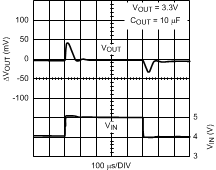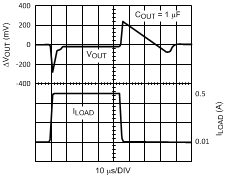SNVS322M December 2004 – December 2015 LP38690 , LP38692
PRODUCTION DATA.
- 1 Features
- 2 Applications
- 3 Description
- 4 Revision History
- 5 Pin Configuration and Functions
- 6 Specifications
- 7 Detailed Description
- 8 Application and Implementation
- 9 Power Supply Recommendations
- 10Layout
- 11Device and Documentation Support
- 12Mechanical, Packaging, and Orderable Information
Package Options
Mechanical Data (Package|Pins)
Thermal pad, mechanical data (Package|Pins)
Orderable Information
6 Specifications
6.1 Absolute Maximum Ratings
over operating free-air temperature range (unless otherwise noted)(1)| MIN | MAX | UNIT | ||
|---|---|---|---|---|
| V(max) All pins (with respect to GND) | –0.3 | 12 | V | |
| IOUT(3) | Internally limited | |||
| Junction temperature | −40 | 150 | °C | |
| Lead temperature (soldering, 5 seconds) | 260 | |||
| Power dissipation(2) | Internally limited | |||
| Storage temperature, Tstg | –65 | 150 | °C | |
(1) Stresses beyond those listed under Absolute Maximum Ratings may cause permanent damage to the device. These are stress ratings only, which do not imply functional operation of the device at these or any other conditions beyond those indicated under Recommended Operating Conditions. Exposure to absolute-maximum-rated conditions for extended periods may affect device reliability.
(2) At elevated temperatures, device power dissipation must be derated based on package thermal resistance and heatsink values (if a heatsink is used). When using the WSON package, refer to TI Application Report AN-1187 Leadless Leadframe Package (LLP) (SNOA401) and the WSON Mounting section in this datasheet. If power dissipation causes the junction temperature to exceed specified limits, the device goes into thermal shutdown.
(3) If used in a dual-supply system where the regulator load is returned to a negative supply, the output pin must be diode clamped to ground.
6.2 ESD Ratings
| VALUE | UNIT | |||
|---|---|---|---|---|
| V(ESD) | Electrostatic discharge | Human-body model (HBM), per ANSI/ESDA/JEDEC JS-001(1) | ±2000 | V |
(1) JEDEC document JEP155 states that 500-V HBM allows safe manufacturing with a standard ESD control process.
6.3 Recommended Operating Conditions
over operating free-air temperature range (unless otherwise noted)| MIN | NOM | MAX | UNIT | ||
|---|---|---|---|---|---|
| VIN supply voltage | 2.7 | 10 | V | ||
| Operating junction temperature | −40 | 125 | °C | ||
6.4 Thermal Information
| THERMAL METRIC(1) | LP38690 | LP38690/92 | LP38692 | UNIT | |
|---|---|---|---|---|---|
| TO-252 | WSON | SOT-223 | |||
| 3 PINS | 6 PINS | 5 PINS | |||
| RθJA(2) | Junction-to-ambient thermal resistance | 50.5 | 50.6 | 68.5 | °C/W |
| RθJC(top) | Junction-to-case (top) thermal resistance | 52.6 | 44.4 | 52.2 | °C/W |
| RθJB | Junction-to-board thermal resistance | 29.7 | 24.9 | 13.0 | °C/W |
| ψJT | Junction-to-top characterization parameter | 4.8 | 0.4 | 5.5 | °C/W |
| ψJB | Junction-to-board characterization parameter | 29.3 | 25.1 | 12.8 | °C/W |
| RθJC(bot) | Junction-to-case (bottom) thermal resistance | 1.5 | 5.4 | n/a | °C/W |
(1) For more information about traditional and new thermal metrics, see the Semiconductor and IC Package Thermal Metrics application report, SPRA953.
(2) Junction-to-ambient thermal resistance, High-K.
6.5 Electrical Characteristics
Unless otherwise specified: VIN = VOUT + 1 V, CIN = COUT = 10 µF, ILOAD = 10 mA, and limits are for TJ = 25°C. Minimum (MIN) and maximum (MAX) limits are specified through testing, statistical correlation, or design.| PARAMETER | TEST CONDITIONS | MIN | TYP(1) | MAX | UNIT | ||
|---|---|---|---|---|---|---|---|
| VOUT | Output voltage tolerance | –2.5 | 2.5 | %VOUT | |||
| 100 µA < IL < 1 A VO + 1 V ≤ VIN ≤ 10 V −40°C ≤ TJ ≤ 125°C |
–5 | 5 | |||||
| ΔVOUT/ΔVIN | Output voltage line regulation(2) | VOUT + 0.5 V ≤ VIN ≤ 10 V IL = 25 mA |
0.03 | %/A | |||
| VOUT + 0.5 V ≤ VIN ≤ 10 V IL = 25 mA −40°C ≤ TJ ≤ 125°C |
1 | ||||||
| ΔVOUT/ΔIL | Output voltage load regulation(3) | 1 mA < IL < 1 A VIN = VOUT + 1 V |
1.8 | V | |||
| 1 mA < IL < 1 A VIN = VOUT + 1 V −40°C ≤ TJ ≤ 125°C |
5 | ||||||
| VIN – VOUT | Dropout voltage(4) | VOUT = 1.8 V IL = 1 A |
950 | mV | |||
| VOUT = 1.8 V IL = 1 A −40°C ≤ TJ ≤ 125°C |
1600 | ||||||
| VOUT = 2.5 V | IL = 0.1 A | 80 | |||||
| IL = 1 A | 800 | ||||||
| VOUT = 2.5 V −40°C ≤ TJ ≤ 125°C |
IL = 0.1 A | 145 | |||||
| IL = 1 A | 1300 | ||||||
| VOUT = 3.3 V | IL = 0.1 A | 65 | |||||
| IL = 1 A | 650 | ||||||
| VOUT = 3.3 V −40°C ≤ TJ ≤ 125°C |
IL = 0.1 A | 110 | |||||
| IL = 1 A | 1000 | ||||||
| VOUT = 5 V | IL = 0.1 A | 45 | |||||
| IL = 1 A | 450 | ||||||
| VOUT = 5 V, −40°C ≤ TJ ≤ 125°C |
IL = 0.1 A | 100 | |||||
| IL = 1 A | 800 | ||||||
| IQ | Quiescent current | VIN ≤ 10 V, IL = 100 µA to 1 A | 55 | µA | |||
| VIN ≤ 10 V, IL = 100 µA to 1 A −40°C ≤ TJ ≤ 125°C |
100 | ||||||
| VEN ≤ 0.4 V (LP38692 only) | 0.001 | ||||||
| IL(MIN) | Minimum load current | VIN – VOUT ≤ 4 V −40°C ≤ TJ ≤ 125°C |
100 | ||||
| IFB | Foldback current limit | VIN – VOUT > 5 V | 450 | mA | |||
| VIN – VOUT < 4 V | 1500 | ||||||
| PSRR | Ripple rejection | VIN = VOUT + 2 V(DC), with 1V(p-p) / 120 Hz ripple | 55 | dB | |||
| TSD | Thermal shutdown activation (junction temp) | 160 | °C | ||||
| TSD (HYST) | Thermal shutdown hysteresis (junction temp) | 10 | |||||
| en | Output noise | VOUT = 3.3 V, BW = 10 Hz to 10 kHz | 0.7 | µV/√Hz | |||
| VOUT (LEAK) | Output leakage current | VOUT = VOUT(NOM) + 1 V at 10 VIN | 0.5 | 12 | µA | ||
| VEN | Enable voltage (LP38692 only) | Output = OFF, −40°C ≤ TJ ≤ 125°C | 0.4 | V | |||
| Output = ON, VIN = 4 V −40°C ≤ TJ ≤ 125°C |
1.8 | ||||||
| Output = ON, VIN = 6 V −40°C ≤ TJ ≤ 125°C |
3 | ||||||
| Output = ON, VIN = 10 V −40°C ≤ TJ ≤ 125°C |
4 | ||||||
| IEN | Enable pin leakage | VEN = 0 V or 10 V, VIN = 10 V | –1 | 0.001 | 1 | µA | |
(1) Typical numbers represent the most likely parametric norm for 25°C operation.
(2) Output voltage line regulation is defined as the change in output voltage from nominal value resulting from a change in input voltage.
(3) Output voltage load regulation is defined as the change in output voltage from nominal value as the load current increases from 1 mA to full load.
(4) Dropout voltage is defined as the minimum input to output differential required to maintain the output within 100 mV of nominal value.
6.6 Typical Characteristics
Unless otherwise specified: TJ = 25°C, CIN = COUT = 10 µF, EN pin is tied to VIN (LP38692 only), VOUT = 1.8 V, VIN = VOUT + 1 V, IL = 10 mA.























